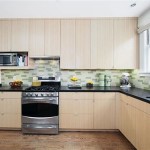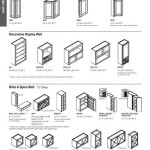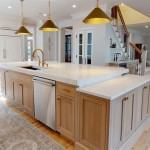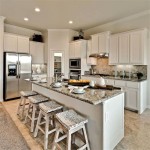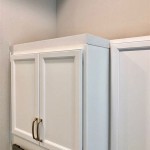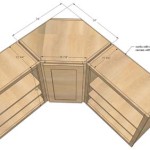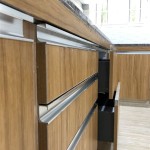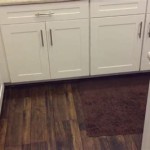Black Kitchen Cabinets With Red Walls: A Bold and Striking Design Choice
The combination of black kitchen cabinets and red walls represents a design choice that is both bold and undeniably striking. This pairing deviates from conventional kitchen aesthetics, demanding careful consideration and execution to achieve a balanced and visually appealing space. The stark contrast between the deep, grounding black and the vibrant, energetic red creates a dynamic that can be both captivating and, if not properly managed, overwhelming. This article will explore the nuances of designing a kitchen incorporating black cabinets and red walls, focusing on key considerations and stylistic approaches to ensure a successful and harmonious design.
The inherent drama in this color scheme stems from the opposing nature of the hues. Black, often associated with sophistication, elegance, and a sense of grounding, provides a strong visual anchor within the space. Red, on the other hand, is a color of passion, energy, and excitement, immediately drawing the eye and injecting a sense of vibrancy. The interplay between these two colors creates a visually stimulating environment, but it also requires a nuanced understanding of color theory and spatial design to avoid a disorienting or visually jarring outcome.
Before embarking on this design journey, it's crucial to assess the existing architectural features of the kitchen. Natural light, the size of the space, and the existing flooring all play a crucial role in how the black and red combination will ultimately manifest. A small, poorly lit kitchen might feel claustrophobic and oppressive with such a dark and intense color palette. Conversely, a large, open-plan kitchen with ample natural light can handle the dramatic contrast more effectively. The existing flooring should also be considered; a neutral tile or hardwood floor can provide a grounding element that balances the boldness of the cabinets and walls.
Understanding Red: Hue, Saturation, and Value
The selection of the specific shade of red is paramount to the success of this design scheme. Red is a broad spectrum, ranging from deep crimson to bright cherry red, each with its own unique characteristics and impact on the overall ambiance of the kitchen. A deep, muted red, such as burgundy or brick red, can evoke a sense of warmth and sophistication, pairing well with a more traditional or transitional kitchen style. These darker shades of red tend to be less overwhelming and can create a more inviting and comfortable atmosphere.
On the other hand, a brighter, more saturated red, such as fire engine red or scarlet, injects a high dose of energy and vibrancy into the space. These bolder shades are better suited for contemporary or modern kitchens, where they can be used to accentuate architectural details or create a focal point. However, it's crucial to use these brighter reds judiciously, as they can easily overpower the space and create a sense of visual fatigue. Consider using a brighter red as an accent color, perhaps on a single wall or in smaller decorative elements.
The finish of the red paint also contributes significantly to the overall effect. A matte finish will absorb more light, creating a softer, more muted effect. A glossy finish, on the other hand, will reflect more light, making the red appear brighter and more intense. The choice of finish should be aligned with the desired aesthetic and the amount of natural light available in the kitchen. In a smaller kitchen, a glossy finish on the red walls can help to reflect light and make the space feel more open.
Black Cabinet Styles and Complementary Materials
The style of the black kitchen cabinets is another critical consideration. Sleek, modern black cabinets with minimalist hardware create a sophisticated and contemporary aesthetic. Shaker-style black cabinets, with their clean lines and recessed panels, offer a more classic and versatile look that can be adapted to a variety of kitchen styles. Raised-panel black cabinets, with their intricate detailing, lend a more traditional and formal feel to the space.
The choice of countertop material can significantly enhance the overall design. White or light-colored countertops, such as marble or quartz, provide a stark contrast to the black cabinets and create a visually appealing balance. The light surface of the countertop helps to reflect light and prevent the kitchen from feeling too dark. Granite countertops with subtle veining in shades of gray or beige can also complement the black cabinets without overwhelming the space.
Hardware choices play a crucial role in completing the cabinet design. Brushed nickel or stainless steel hardware offers a sleek and modern look, while brass or gold hardware adds a touch of warmth and sophistication. The hardware should complement the overall style of the kitchen and the chosen countertop material. For example, brass hardware pairs well with marble countertops and traditional black cabinets, while stainless steel hardware is a natural fit for modern black cabinets and quartz countertops.
Balancing the Contrast: Lighting and Accents
Lighting is perhaps the most crucial element in a kitchen featuring black cabinets and red walls. Ample and well-placed lighting is essential to counteract the darkness of the cabinets and the intensity of the walls. A combination of ambient, task, and accent lighting is necessary to create a balanced and functional space. Recessed lighting provides overall illumination, while under-cabinet lighting illuminates the countertops and workspace. Pendant lights over the island or dining area can add a touch of style and visual interest.
The type of lighting chosen also impacts the perception of the colors. Warm-toned lighting can soften the contrast between the black and red, creating a more inviting and cozy atmosphere. Cool-toned lighting, on the other hand, can accentuate the contrast and create a more modern and dramatic look. The choice of lighting should be carefully considered based on the desired aesthetic and the overall ambiance of the kitchen.
Accent colors and decorative elements can be used to further balance the contrast and add visual interest to the space. Metallic accents, such as copper, gold, or silver, can add a touch of glamour and sophistication. Incorporating natural elements, such as plants or wooden accents, can soften the harshness of the black and red and create a more organic and inviting feel. Strategically placed artwork or decorative accessories in neutral colors can also help to break up the intensity of the color scheme and add a personal touch.
Ultimately, designing a kitchen with black cabinets and red walls requires a thoughtful and deliberate approach. By carefully considering the nuances of color theory, spatial design, and lighting, it is possible to create a space that is both visually stunning and functionally practical. The success of this design lies in achieving a harmonious balance between the bold and dramatic elements, resulting in a kitchen that is both unique and inviting.

House Ideas Dark Cabinets Dream Black Kitchens Steel Accents Kitchen Dining Room Darkred Re Wall Design Red Decor Walls

My Kitchen Will Have Red Walls But With Dark Brown Cabinets Instead Of Black Decor

Love The Red Kitchen And Dark Wood Maybe Only One Wall Accents Design Walls Colors

Rhinetta Homes Photo Albums Red Kitchen Walls Black Cabinets

Red Kitchen Walls Black Cabinets Transitional Design Gourmet

Dark Cabinets And Light Wood Floor Red Kitchen Walls White Design Renovation

Red Kitchen Design Ideas Pictures And Inspiration Black Decor Interior

30 Red Kitchens For The Boldest Among Us Kitchen Decor Walls

Love The Red In This Kitchen Walls Colors

Red Black And White Interiors Living Rooms Kitchens Bedrooms
Related Posts

